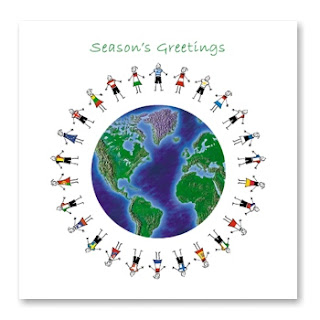 to everyone passing by. Thanks to everyone who visited and may 2009 be one of peace, joy and happy blogging.
to everyone passing by. Thanks to everyone who visited and may 2009 be one of peace, joy and happy blogging.
Tuesday 23 December 2008
Season's Greetings
 to everyone passing by. Thanks to everyone who visited and may 2009 be one of peace, joy and happy blogging.
to everyone passing by. Thanks to everyone who visited and may 2009 be one of peace, joy and happy blogging.
Friday 19 December 2008
A-Z guide to a Spanish Christmas
Ollas, Lotería, Uvas? What do these have in common with Christmas? Theresa O'Shea explains.
Theresa and Valerie produced the very amusing book "Estar en el ajo" referred to in a previous post, with the link to their website. For those of you who tried to access it before , it now works.
Árbol What’s a fir tree got to do with a traditional Spanish Christmas? Like reindeer and sleigh bells and Papa Noel himself, not a lot. But as
Belén Christmas crib, or Nativity Scene. Belén actually means
Cava Catalunya's greatest gift to the world: affordable, drinkable champers. While bottles of the stuff are frequently uncorked at Christmas parties and gatherings throughout
Dulces Sweet things. OK, so the Spanish do savoury brilliantly: hams, cheeses, olives and all the other salt of the earth stuff. But it's hard to get excited about mantecados and polverones: lardy cakey, biscuity things that glue your mouth together and come in terrifyingly large boxes.
Esteban Steven, as in Saint Steven's Day. 26 December is a bit of a damp squid in most of
Figurines for the Nativity Scene. These were originally made of porcelain, and later baked clay and plaster. It took the wonders of the hundred-peseta shop to turn an artisan art form into mass-produced tack. Apart from the main players, you can buy a whole range of village extras, including the kids’ favourite, el cagón or, in Catalan and Valenciano, el caganer (the, er, crapper). What a country lad with his trousers round his ankles has to do with the holy scene is anybody's guess.
(and for the latest addition of Barak Obama to the el cagón family, click HEREHigos Figs. After the shellfish comes a soup of some kind; for the main course there's turkey, fish, goat or lamb; then perhaps a light dessert; and finally – to aid digestion? - out comes the Muscatel and the frutos secos: almonds, hazelnuts, dates, apricots, and figs. If you're a fig fan, don't miss pan de higos – a thick nutty “cake” packed solid with the contents of several fig trees.
Inocentes, el día de los
Jamón Christmas is a grim a time for pigs, especially the patiently-fattened acorn-eating variety. One false turn in Carrefour and you'll find yourself suddenly hemmed in by ceilings of swinging forelegs and hind legs, interspersed with extra-large, extra-phallic chorizos (sausages). Of all the festive foodstuffs it is the jamón, lovingly mounted on its cutting stand and covered with a damp cloth, without which the Spanish Christmas hamper would never be complete.
Lotería A staggering 90 percent of the population take part in the world's most famous and "fattest" lottery, El Gordo. Hardly surprising with prize money totalling EUR 1.8 billion. On the morning of the draw (22 December), any local bar is the place to be, where everyone will be glued to the TV screen, clutching their décimas and participaciones (more affordable fractions of full numbers) as the children of the San Ildefonso orphanage pull out and sing-song the winning numbers.
Misa de Gallo Rooster mass, as the Spanish call our equivalent of
Noche Buena Christmas Eve. Most Spaniards rate this as the most important of all the Christmas feast days. It's the only time, other than summer siesta hours, when streets are deserted and bars and restaurants close. But don't be fooled, the action simply moves indoors. On this "good night” the latest-suppering country in the world goes for gold, with most Christmas dinners starting around eleven or
Ollas Saucepans. Preferably large enough to bath a small child, considering that it's quite normal for 20 or 30 family members to eat together over the Christmas period.
Pascua, Flor de Poinsettia. A recent addition to the Christmas decor. Striking though they are, with their deep-red star flowers and velvety green leaves, I've yet to buy one that lasted beyond Reyes. (see R)
Quo Vadis You can guarantee this epic will be on television, along with Qué
Reyes Kings' Day. In
Santa, or Papa Noel The purists don't like it, but
Tió, as in cagar el tió. Put as delicately as I can manage, "making the log drop its load". A charming Christmas Eve custom in Catalunya that involves singing special songs and beating on a blanket-covered log (the family tió) until the presents pop out.
Uvas Grapes. We sing Auld Lang Syne and hold hands while the Spanish eat a dozen grapes. The tradition was started by the wine merchants of yesteryear, giving the locals plenty of time to develop a 12-lucky-grapes gene. Year after year as I choke on green pulp and pips, my Spanish friends down theirs effortlessly. In 1996, however, even the most adept swallowers came unstuck when the clock of the Puerta del Sol in
Villancicos Carols. Forget solemn. Think hand-clapping, foot-stomping, pub-type sing-a-longs and you've captured the essence of Spanish carol-singing. Traditionally takes place around the belén, with everyone banging on a medley of home-made instruments - anís bottle and spoon, mortar and pestle, paper comb, jars of lentils and a zambomba (see Z). Probably the catchiest of all villancicos is the ubiquitous “Mira cómo beben los peces en el río” (Look how the fishes are drinking in the river).
White Christmas Blanca Navidad, covered by old crooner Rafael, is as much a part of the season here as in the
Xixona Cheating a bit here, the Castilian spelling is Jijona and it's the name of a town near
Yemas Egg yolks. We have

Zambomba Key instrument for villancico (see V) sessions. Basically an upturned bottomless flower-pot with a drum-skin stretched across one end and a hole in the middle through which a pole fits. To produce the instrument's low zam-bom, zam-bom sound the player spits on his or her hand and moves it up and down the pole. That's the theory, at any rate. My efforts suggest there might be a zambomba gene out there somewhere.
If you enjoy their style, visit their website as there are more stories there.
Sunday 7 December 2008
Simple Truths
I've developed a passion for lists over the years. Unlike now where lists are essential, I didn't need them, but I always had a list of "to-do" things which always ended with "do nothing". This was good advice from a friend to help me overcome a time of extended sick leave when I felt bereft of the structure of my job.
This week I've received from SimpleTruths.com another piece of good advice which brings together list making and displacement activity..... "eat that frog". Go take a look http://www.eatthatfrogmovie.com/
Don't forget to turn up the volume.
Thursday 4 December 2008
Another time-consuming passion
He is a night-bird so every evening when I hit the sack around 11, he stays up till 1 or 2 a.m. wrestling with sophisticated art software programs to produce locomotives and tenders from times gone by. It's complicated, time-consuming work and the air has been blue at times as he frequently "forgets" to read the manual (you know the phrase - RTFM!) and spends hours figuring out how to do something only to find the easy answer when he consults the tutorials.
Anyway, the current results are HERE
There are some sections still being built but there are enough illustrations and explanations to interest that strange breed of people, affectionately known as "anoraks" who love the age of steam. Enjoy.
Tuesday 2 December 2008
November Sundown
People who visit our garden take one look at the bottles that hang in the pear tree and say "why are those there?".
We explain about the sun shining through them when its low in the sky. Here it is.......worth it, eh?




